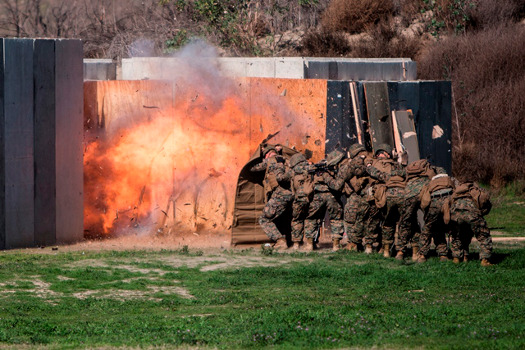 |
| February 07, 2017 | Volume 13 Issue 05 |
Designfax weekly eMagazine
Archives
Partners
Manufacturing Center
Product Spotlight
Modern Applications News
Metalworking Ideas For
Today's Job Shops
Tooling and Production
Strategies for large
metalworking plants
Like something out of a video game, Navy blast detector will recognize brain injury status for warfighters in real time

Marines shield themselves from a detonated explosive charge during an urban leaders course at Camp Pendleton, CA. To better protect warfighters from possible traumatic brain injuries (TBI) resulting from explosive blasts, the Office of Naval Research is sponsoring the development of a portable system called BLAST that can measure blast pressure, establish injury thresholds for the brain, and analyze potential TBI symptoms. [U.S. Marine Corps photo by Sgt. Emmanuel Ramos]
Modern body armor better protects warfighters against shrapnel from explosive blasts. However, they still face a hidden threat -- the resulting blast pressure and shock wave that could cause traumatic brain injury (TBI).
To fight this invisible, insidious adversary, the Office of Naval Research (ONR) is sponsoring the development of a portable, three-part system that can measure blast pressure, establish injury thresholds for the brain, and analyze potential TBI symptoms. It's called Blast Load Assessment Sense and Test -- BLAST, for short.
"A system like BLAST is vitally important because it can help recognize the signs of TBI early and tell warfighters they might need medical attention," said Dr. Timothy Bentley, a program manager overseeing the research for ONR's Warfighter Performance Department. "This reduces the likelihood of someone enduring multiple blasts and suffering more serious brain injury. BLAST also is unique for its unique suite of technology."
Department of Defense doctrine requires all those within 50 m (approximately 165 ft) of an explosion to "stand down" for 24 hours and undergo a mandatory medical checkup. Bentley said this approach presents two major challenges: First, some forward operating bases are only 100 m (approximately 330 ft) across, so half of the personnel would need to stand down after an explosion. Second, 24 hours isn't enough time for a regular medical exam to detect signs of even mild TBI.
BLAST uses coin-sized sensors that are tough enough to survive an explosion, can be worn on helmets and body armor, and are able to record blast pressure. This pressure can be downloaded with a specialized scanner -- design possibilities include a handheld barcode-style scanner or a stationary one modeled after airport metal detectors. By using a special algorithm to convert data into a "go or no-go" injury threshold, BLAST indicates if exposed warfighters can stay in the fight or need a TBI-focused medical exam with the third component called a neurofunctional assessment tool.
This assessment tool is sized like a computer mouse, fits in the palm of the hand, and emits vibrations to stimulate fingertip sensations and assess brain health. By testing whether or not warfighters feel these vibrations, administered in a variety of patterns, a medic or corpsman can decide if someone exhibits TBI symptoms and needs to stand down.
"BLAST sensors can provide valuable blast pressure data that can be used to assess the possibility of TBI," said Dr. Amit Bagchi, a scientist at the Naval Research Laboratory, which is developing the physical sensors. "The more data we have, the better we can predict the presence of TBI."
"Together, the components of BLAST can enable us to designate a pressure threshold number for when someone is at risk for TBI and needs to stand down for more advanced testing or medical care," said Dr. Laila Zai, a scientist with ARA, a research and engineering company helping to develop BLAST's algorithm and neurofunctional assessment tool. "Think of a speedometer. Whether you're going too fast or slow depends on road conditions and is indicated by the speed limit. BLAST determines a safe 'speed' for the brain."
BLAST sensors currently are being tested in laboratories using electrical shocks to simulate blasts of varying size and intensity. Within the next year and a half, Bentley said, the system should be tested on field mannequins and then by Marines completing breacher training -- overcoming obstacles such as walls and doors using explosives.
BLAST is part of ONR's Future Naval Capability, a science and technology program aimed at developing and transitioning cutting-edge technology products to Navy and Marine Corps acquisition managers within a three- to five-year timeframe.
Published February 2017
Rate this article
View our terms of use and privacy policy
